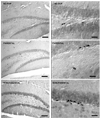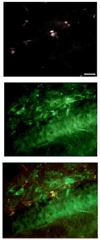Pup exposure elicits hippocampal cell proliferation in the prairie vole
- PMID: 17913255
- PMCID: PMC2699755
- DOI: 10.1016/j.bbr.2007.08.028
Pup exposure elicits hippocampal cell proliferation in the prairie vole
Abstract
The onset of parental behavior has profound and enduring effects on behavior and neurobiology across a variety of species. In some cases, mere exposure to a foster neonate (and a subsequent parental response) can have similar effects. In the present experiment, we exposed adult male and female prairie voles (Microtus ochrogaster) to two foster pups for 20 min and quantified cell proliferation in the dentate gyrus of the hippocampus (DG), medial amygdala (MeA) and cortical amygdala (CorA). Prairie voles are highly social rodents that typically display biparental care and spontaneous parental care when exposed to foster pups. Comparisons were made between the animals that responded parentally or non-parentally towards the pups, as well as control conditions. Cell proliferation was assessed using injections of 5-bromo-2'-deoxyuridine (BrdU) and immunocytochemical localization of this marker. The phenotype of the cells was determined using double label immunofluoresence for BrdU and TuJ1 (a neuronal marker). An increase in cell proliferation in the DG was seen in animals exposed to pups. However, animals that responded non-parentally had a greater number of BrdU labeled cells in the DG compared to those that responded parentally. The majority of BrdU labeled cells co-expressed TuJ1 across all groups. These results demonstrate that exposure to a foster pup and the behavioral reaction to it (parental or non-parental) are associated with site-specific changes in cell proliferation.
Figures





Similar articles
-
Estrogen regulation of cell proliferation and distribution of estrogen receptor-alpha in the brains of adult female prairie and meadow voles.J Comp Neurol. 2005 Aug 22;489(2):166-79. doi: 10.1002/cne.20638. J Comp Neurol. 2005. PMID: 15984004 Free PMC article.
-
The effects of social environment on adult neurogenesis in the female prairie vole.J Neurobiol. 2002 May;51(2):115-28. doi: 10.1002/neu.10042. J Neurobiol. 2002. PMID: 11932953
-
Fatherhood reduces the survival of adult-generated cells and affects various types of behavior in the prairie vole (Microtus ochrogaster ).Eur J Neurosci. 2013 Nov;38(9):3345-55. doi: 10.1111/ejn.12323. Epub 2013 Jul 31. Eur J Neurosci. 2013. PMID: 23899240 Free PMC article.
-
Chemosensory cues affect amygdaloid neurogenesis and alter behaviors in the socially monogamous prairie vole.Eur J Neurosci. 2014 May;39(10):1632-41. doi: 10.1111/ejn.12531. Epub 2014 Mar 19. Eur J Neurosci. 2014. PMID: 24641515 Free PMC article.
-
Species differences in behavior and cell proliferation/survival in the adult brains of female meadow and prairie voles.Neuroscience. 2016 Feb 19;315:259-70. doi: 10.1016/j.neuroscience.2015.12.026. Epub 2015 Dec 19. Neuroscience. 2016. PMID: 26708743 Free PMC article.
Cited by
-
The social environment and neurogenesis in the adult Mammalian brain.Front Hum Neurosci. 2012 May 8;6:118. doi: 10.3389/fnhum.2012.00118. eCollection 2012. Front Hum Neurosci. 2012. PMID: 22586385 Free PMC article.
-
Social isolation impairs adult neurogenesis in the limbic system and alters behaviors in female prairie voles.Horm Behav. 2012 Sep;62(4):357-66. doi: 10.1016/j.yhbeh.2012.03.005. Epub 2012 Mar 23. Horm Behav. 2012. PMID: 22465453 Free PMC article.
-
The neurobiological causes and effects of alloparenting.Dev Neurobiol. 2017 Feb;77(2):214-232. doi: 10.1002/dneu.22465. Epub 2016 Nov 25. Dev Neurobiol. 2017. PMID: 27804277 Free PMC article. Review.
-
Interactions with the young down-regulate adult olfactory neurogenesis and enhance the maturation of olfactory neuroblasts in sheep mothers.Front Behav Neurosci. 2014 Feb 18;8:53. doi: 10.3389/fnbeh.2014.00053. eCollection 2014. Front Behav Neurosci. 2014. PMID: 24600367 Free PMC article.
-
Oxytocin Manipulation Alters Neural Activity in Response to Social Stimuli in Eusocial Naked Mole-Rats.Front Behav Neurosci. 2018 Nov 20;12:272. doi: 10.3389/fnbeh.2018.00272. eCollection 2018. Front Behav Neurosci. 2018. PMID: 30515085 Free PMC article.
References
-
- Becker S. A computational principle for hippocampal learning and neurogenesis. Hippocampus. 2005;15:722–738. - PubMed
-
- Brown J, Cooper-Kuhn CM, Kempermann G, van Praag H, Winkler J, Gage FH, Kuhn HG. Enriched environment and physical activity stimulate hippocampal but not olfactory bulb neurogenesis. Eur J Neurosci. 2003;17:2042–2046. - PubMed
-
- Clutton-Brock TH. Evolution of Parental Care. Princeton: Princeton University Press; 1991.
-
- Cushing BS, Klein D, Hoffman GE, Carter CS, Le WW, DeVries GJ. Comparison of fixation techniques: immersion versus perfusion. Horm. Behav. 2001;39:326.
Publication types
MeSH terms
Substances
Grants and funding
LinkOut - more resources
Full Text Sources

